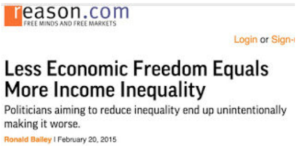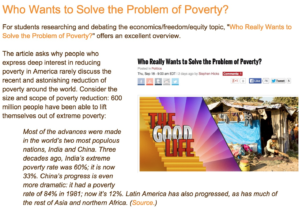As Economic Freedom Rises, Wealth Increases, and Income Inequality Falls

… according to a study comparing outcomes in all U.S. states in the January 2014 issue of Contemporary Economic Policy by Illinois State University economist Oguzhan Dincer and his colleagues finds that reducing economic freedom actually tends to increase inequality. “On average, as the size and scope of government increases, so does income inequality,” Dincer tells Reason.
The researchers argue that marketplace interventions, even those designed to reduce inequality, tend to reduce economic opportunities and increase income inequality further.
Bailey explains why income-inequality increases at first in developing countries like China and India and the U.S. in the late 1800s and early 1900s:
First consider the big picture. Progressives are fond of citing data that shows that income inequality in the United States was falling throughout the 1950s and 1960s. The trend seemed to be following a hypothesis proposed by the economist Simon Kuznets. As economic growth takes off, Kuznets argued, income inequality initially increases as some workers move from low-productivity sectors into higher-productivity sectors. As the higher-productivity sectors absorb a growing proportion of workers, income inequality then begins to decrease, producing the famous inverse-U-shaped relationship between income inequality and economic growth. [Source.]
The Fraser Institute’s Economic Freedom of North America index allows researchers to test this theory that economic freedom reduces income inequality.
A Canadian free-market think tank, the Fraser Institute, issues an annual report on the Economic Freedom of North America, analyzing how each U.S. state and Canadian province stacks up with regard to measures such as taxation, government spending, and labor market freedom. Dincer’s study analyzes trends in both economic freedom and income inequality among the states between 1981 and 2004, finding that “economic freedom reduces income inequality both in the short and the long run.”
Bailey explains how this claim is derived from economic freedom index data:
To get a rough idea of how this works, let’s compare the eight states with the greatest economic freedom to the eight that scored the lowest. The eight states with the highest economic index scores, ranging from 7.8 to 7.1, were Texas, South Dakota, North Dakota, Virginia, New Hampshire, Louisiana, Nebraska, and Delaware. The eight states with the lowest scores, ranging from 5.2 to 5.8, were Maine, Vermont, Mississippi, New York, Rhode Island, West Virginia, New Jersey, and California. Averaging the U.S. Census Bureau’s 2012 Gini coefficients for both groups, one finds that the Gini coefficient for the economically freer group is 0.452 whereas the one for the less free group is 0.469. In other words, income inequality is higher in the less economically free states.
Why does economic freedom matter so much to income inequality? Economist (and former debater) Tyler Cowen discusses the connection in his April 3, 2015 New York Times column “It’s Not the Inequality; It’s the Immobility.”
Cowen begins:
Income inequality and economic immobility are often lumped together, but they shouldn’t be.
Consider the two concepts positively: Income equality is about bridging the gap between the rich and the poor, while economic mobility is about elevating the poor as rapidly as possible. Finding ways to increase economic mobility should be our greater concern.
Cowen argues that slowing productivity is more the problem that increasing income inequality. Here is how he makes his case:
Data from the Economic Report of the President suggests that if productivity growth had maintained its pre-1973 pace, the median or typical household would now earn about $30,000 more today. Those higher earnings would constitute a form of upward mobility. For purposes of comparison, if income inequality had maintained its pre-1973 trend, the gain for the median household would be about $9,000 in income this year, a much smaller figure.
Cowen notes that absolute poverty in the U.S. has fallen since the 1960s, but regulations that block or slow entry into occupations reduce opportunities, especially for low-income Americans:
To see how a perspective dominated by mobility differs from one focusing on inequality, consider the licensing of occupations like interior decorators and barbers. This licensing, which covers an increasing part of the American labor market, limits economic opportunities for many lower earners and thus hinders mobility.
But if we relax licensing for a particular sector, that will most likely create some wealthy people, and also some business losers, and it is quite possible that measured income inequality will rise. That may not register as a net gain according to the formal metrics of the egalitarian, but there is more opportunity, and greater liberty to earn a living as one sees fit. The inequality focus tends to draw us to redistribution, whereas a mobility focus is more conducive to ideas for wealth creation.
Charles Murray, in his May 11 Wall Street Journal essay, “Regulation Run Amok–And How to Fight It,” makes a powerful case for civil disobedience, suggesting the Uber route of inviting local drivers on board, even when City Councils and taxi monopolies make Uber illegal.
Murray writes that the presumption of freedom has faded since the New Deal policies and regulations:
It was our boast that in America, unlike in any other country, you could live your life as you saw fit as long as you accorded the same liberty to everyone else. The “sum of good government,” as Thomas Jefferson put it in his first inaugural address, was one “which shall restrain men from injuring one another” and “shall leave them otherwise free to regulate their own pursuits of industry and improvement.” Americans were to live under a presumption of freedom. …
We now live under a presumption of constraint. Put aside all the ways in which city and state governments require us to march to their drummers and consider just the federal government. The number of federal crimes you could commit as of 2007 (the last year they were tallied) was about 4,450, a 50% increase since just 1980. A comparative handful of those crimes are “malum in se”—bad in themselves. The rest are “malum prohibitum”—crimes because the government disapproves.
Corruption of the legal system contributes to the regulatory excess. Abandoning the separate of powers doctrine that long separated legal from judicial and executive powers collapses all power into regulatory agencies:
It gets worse. If a regulatory agency comes after you, forget about juries, proof of guilt beyond a reasonable doubt, disinterested judges and other rights that are part of due process in ordinary courts. The “administrative courts” through which the regulatory agencies impose their will are run by the regulatory agencies themselves, much as if the police department could make up its own laws and then employ its own prosecutors, judges and courts of appeals.
Murray discusses regulations that make getting ahead hard:
Identifying precisely which regulations are pointless, stupid or tyrannical will be a lengthy process, but categories that should come under strict scrutiny include regulations that prescribe best practice for a craft or profession; restrict access to an occupation; prohibit owners of property from using it as they wish; prescribe hiring, firing and working conditions; and prevent people from taking voluntary risks.
Within each category, the task is to discriminate between regulations that should command our voluntary compliance from those that are foolish or worse.
The stakes in the regulatory debate Charles Murray outlines are high. In an earlier post, Who Left $39 Trillion on the Table? I argue that misguided and outdated regulations are costly both in reducing income and wealth and also in raising frustration levels for those trying to get ahead by creating wealth and value for others. The numbers are truly staggering, suggesting Americans are 75% poorer today than they would have been with reasonable safety rules and standards for enterprises:
The growth of federal regulations over the past six decades has cut U.S. economic growth by an average of 2 percentage points per year, according to a new study in the Journal of Economic Growth. As a result, the average American household receives about $277,000 less annually than it would have gotten in the absence of six decades of accumulated regulations—a median household income of $330,000 instead of the $53,000 we get now.
 Sound impossible? Just consider how economic freedom in Hong Kong and Singapore over the last fifty years has enabled dramatically increased incomes. Hong Kong’s population jumped from 3 million in 1960 to 7.2 million in 2014 (and in Singapore, from 1.65 to 5.4 million). Immigrants were mostly impoverished, fleeing communist China. Yet over that time, average income in Hong Kong rose from $4,000 a year in 1960 to $52,722 by 2015. (Heritage 2015 Index of Economic Freedom for 2015 and St. Louis Fed for 1960 data). And the majority in Hong Kong today immigrated since 1960, leaving the much lower income levels of communist China.
Sound impossible? Just consider how economic freedom in Hong Kong and Singapore over the last fifty years has enabled dramatically increased incomes. Hong Kong’s population jumped from 3 million in 1960 to 7.2 million in 2014 (and in Singapore, from 1.65 to 5.4 million). Immigrants were mostly impoverished, fleeing communist China. Yet over that time, average income in Hong Kong rose from $4,000 a year in 1960 to $52,722 by 2015. (Heritage 2015 Index of Economic Freedom for 2015 and St. Louis Fed for 1960 data). And the majority in Hong Kong today immigrated since 1960, leaving the much lower income levels of communist China.
More on the economic freedom miracle of Hong Kong in earlier posts, including: Who Wants to Solve the Problem of Poverty?
